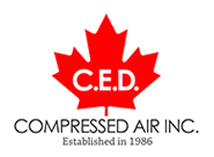Compressed Air Dryers: The Different Types and Their Operating Principles

Table of Contents
- What is a Compressed Air Dryer?
- Things to Know Before Choosing an Air Dryer
- The Three Different Types of Air Dryers
- Deliquescent Air Dryers
- Chemical Air Dryers
- Explore CED’s Line of Compressed Air Dryers
The use of air compressor dryers is essential in many industrial facilities that require a constant supply of dry, compressed air. It is essential to understand the various types of compressed air dryers and their operating principles to select the right one for your facility.
What is a Compressed Air Dryer?
The purpose of an air dryer is to separate moisture from industrially processed air. Dryers are crucial to industrial operations because moisture in industrial air can damage pneumatic systems, freeze pipelines, cause corrosion to metal parts, and cause bacteria or mold growth inside pipes.
Things to Know Before Choosing an Air Dryer
It is important to keep in mind that your business may require multiple types of air compressors, as well as multiple types of air compressor dryers. When researching air dryers, it is wise to know a few things about your air compressor and your business:
- Your compressed air’s specific uses and temperature requirements.
- Your required pressure dew point – This figure is essential for the proper performance of your air compressor. It will also determine the type and strength of the dryer you need.
- The environment within which your air compressor operates.
The Three Different Types of Air Dryers
1) Refrigerated Air Dryers
These are widely used in industrial applications because of their relative ease of maintenance and relative cost-effectiveness. This type includes cycling, non-cycling, and variable speed dryers. For air-drying applications, refrigerated air dryers have no special requirements, such as minimum dew points, and work by cooling air to lower the temperature sufficiently to condense moisture.
Applications
Refrigerated air dryers are suitable for general industrial applications where a moderate pressure dew point is acceptable. They are commonly used in manufacturing, assembly lines, and workshops where the ambient temperature is not extremely low.
Pros and Cons
| Pros | Cons |
|---|---|
| Cost-effective for moderate dew point requirements, easy to operate and maintain, widely available. | Less effective in very cold environments, higher energy consumption compared to some other types, may not achieve very low dew points. |
2) Desiccant-type Air Dryer
Desiccant dryers use desiccant material – specialized drying agents – to adsorb water vapour from process air. A desiccant dryer system comprises two towers ‒ one that dries the air and another that regenerates the desiccant. Single towers are less common, and both are suitable in corrosive and hazardous environments without requiring electricity.
Desiccant materials are hygroscopic substances with a high affinity for water that act as dehumidifiers. The low dew point of these compressed air dryers makes them ideal for colder climates and industries that need super-dry air. There are three types of desiccant air dryers: heated, heatless, and heat of compression.
Applications
Desiccant air dryers are ideal for applications requiring very low dew points, such as in the pharmaceutical, chemical, and electronics industries. They are also suitable for cold climates and processes where moisture can cause significant damage or product spoilage.
Pros and Cons
| Pros | Cons |
|---|---|
| Can achieve very low dew points, effective in a wide range of temperatures, suitable for hazardous environments. | Higher initial cost, requires regular replacement or regeneration of desiccant material, can be more complex to operate. |
3) Membrane Dryers
These dryers are available with a choice of various types of permeable material to extract moisture from processed air. Often used for small projects and single points of use, these dryers are suitable for gas extraction applications, including food production. Membrane dryers are simpler to use, quieter and require less maintenance than other systems.
Applications
Membrane dryers are best suited for point-of-use applications, small-scale operations, and situations where a compact and quiet solution is needed. They are commonly used in laboratories, food and beverage production, and for instrument air.
Pros and Cons
| Pros | Cons |
|---|---|
| Compact and lightweight, quiet operation, low maintenance, no moving parts. | Limited flow capacity, higher operating cost due to compressed air usage for purging, may not achieve extremely low dew points. |
Deliquescent Air Dryers
Applications
Deliquescent air dryers are used in applications where a moderate reduction in moisture content is sufficient, and where the presence of a liquid desiccant is acceptable. They are often found in smaller industrial settings or for specific process needs where extreme dryness is not a primary concern.
Pros and Cons
| Pros | Cons |
|---|---|
| Simple design, low initial cost, no external power required. | Limited drying capacity, requires periodic replenishment of the desiccant material, can introduce chemical residue into the air stream. |
Chemical Air Dryers
Applications
Chemical air dryers are typically used for specialized applications requiring the removal of moisture and other contaminants from compressed air. They are often employed in laboratory settings, sensitive electronic manufacturing, or where extremely pure compressed air is necessary.
Pros and Cons
| Pros | Cons |
|---|---|
| Can remove moisture and other airborne contaminants, suitable for highly sensitive applications. | Higher cost, requires regular replacement of chemical cartridges, limited capacity, potential for chemical carryover. |
Explore CED’s Line of Compressed Air Dryers
Today, compressed air dryers are an integral part of most compressed air systems. It is essential to select the right air dryer for your facility to extend its lifespan and avoid costly shutdowns.
Call us today at CED Compressed Air Inc for more information on our air-compressed dryers or to request a quote.
